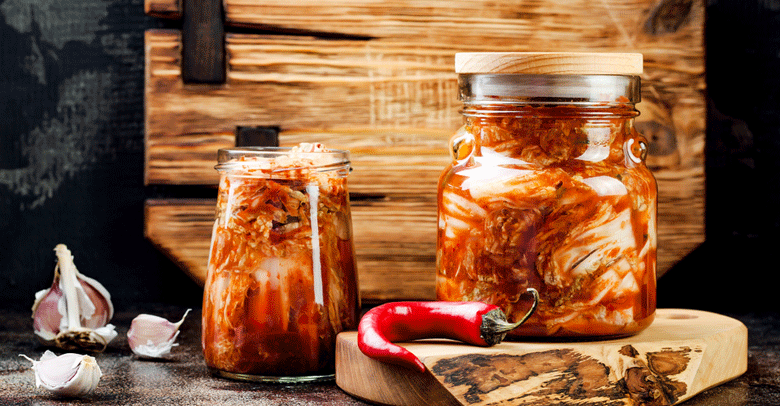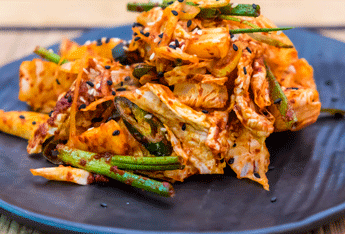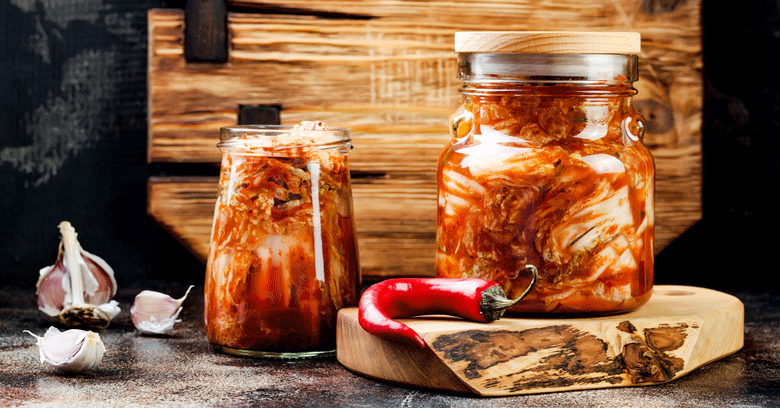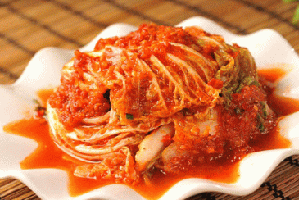[wpseo_breadcrumb]

Baechu Geotjeori ( fresh Kimchi)
Nutrition Information
- Serving size: 100g
- Calories: 39 kcal
- Fat: 2.1 grams
- Saturated fat: 0.3 grams
- Carbohydrates: 4.3 grams
- Sugar: 4.4 grams
- Sodium: 3.5 grams
- Fiber: 2.9 grams
- Protein: 2.8 grams
Recipe type: Salads
Cuisine: Korean
Prep time:
Total time:

Kimchi normally takes more than a week to make because it is fermented. In this fresh salad, version fermentation is skipped, so that it can be eaten on the same day as being made. While it will keep quite safely in the fridge for a week. it is best if eaten fresh. Absolutely fantastic when served with grilled poultry and meats
Ingredients
- Napa cabbage - I small ( about 1 kg)
- Spring onions – 3 ( root removed, chopped into 25mm pieces)
- Daikon radish - 250 grams (optional)
- Coarse salt - 3 tablespoons
- Sugar - 2 teaspoons ( see note *)
- Fish sauce – 2 tablespoons
- Red Chilli flakes - 4 tablespoons ( see note **)
- Garlic – 2 cloves ( finely chopped)
- Fresh ginger – one teaspoon (grated)
- Sesame seeds – 1 teaspoon
- Sesame oil - 1 tablespoon
Instructions
- Hand tear Napa cabbage into bits roughly about 50mm to 75mm long and about 50mm wide
- Slice Daikon radish into bite-size pieces (if using)
- Place half the cabbage and half the radish into a bowl and sprinkle with 1 ½ tablespoons of salt
- Now layer the remaining cabbage and radish on top of the first half and sprinkle with another 1 ½ tablespoons of salt
- Using your hands, mix well so that the salt is thoroughly incorporated through the vegetables
- Allow marination in the salt for 30 – 45 minutes ( see note* )
- In the meantime add the fish sauce, sugar ( see note), garlic, ginger and chilli flakes to a jug or mixing bowl. Stir well, until all the ingredients are well combined
- Once the salting period for the vegetables has elapsed, place them in a colander. Run cold water over and wash out as much salt as possible ( it is best to use your hands to do this)
- Now place the washed vegetables into a large bowl. Add the chopped spring onions and the fish/ Chilli flake sauce previously prepared. Mix well using your hands
- Taste and adjust seasoning if preferred, by adding more sugar ( see note) chilli flakes or fish sauce. Mix in
- Spoon into your serving dish. Sprinkle with sesame seeds and oil
- Serve
Notes
* The more prolonged the vegetables are in the salt, the limper they will become. It is a personal judgment call whether to sacrifice seasoning for crispness
** Traditionally Gochugaru ( Korean chilli flakes) are used, but Aleppo chilli flakes may substitute these
*** Traditionally Maesil Cheong ( Korean green plum syrup ) is used. If you can get your hands on some, it is well worth replacing the sugar with it, Use according to tor personal taste
Keywords: Fresh Kimchi Salad
Sidebar image credit : LWYang / CC BY 2.0 / via Flikr
** Traditionally Gochugaru ( Korean chilli flakes) are used, but Aleppo chilli flakes may substitute these
*** Traditionally Maesil Cheong ( Korean green plum syrup ) is used. If you can get your hands on some, it is well worth replacing the sugar with it, Use according to tor personal taste
Keywords: Fresh Kimchi Salad
Sidebar image credit : LWYang / CC BY 2.0 / via Flikr





